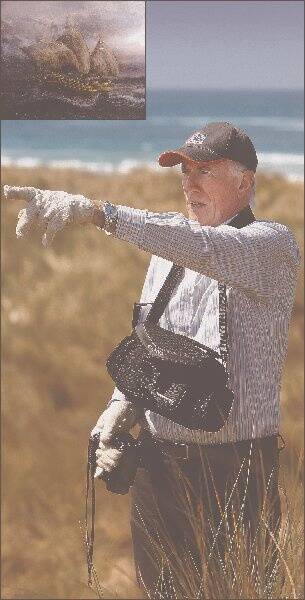
THE fabled Mahogany Ship's exact location in sand dunes near Warrnambool may have been pinpointed for the first time with the use of satellite technology.Images from Google Earth shown to the The Standard this week by Melbourne man Rob Simpson appear to show a clear outline of the vessel under the sand.Mr Simpson, who has been researching the ship for the past 20 years, is convinced that his search is over.Using the Google Earth satellite image co-ordinates, he mapped the location on the coast south of Tower Hill. He drilled three-and-a-half metres down into the sand dunes and got a surprise when he struck something solid."I'm more than satisfied I have found something. Normally when you hit sand it's just a dull thud," Mr Simpson said. "But when I hit the object it made the auger ring. It was exciting, but I'm a fairly cautious person and remained calm."I was just thinking, 'what could it be'."The Google Earth images of the ship's outline are faint, even on a high-resolution computer screen, but exactly match 19th century accounts of where the wreck was originally seen.A Heritage Victoria spokeswoman said its archaeologists would investigate any substantial or credible evidence of shipwrecks in Victoria.It is the first time satellite imagery has been used in the century-old hunt, which Warrnambool Mahogany Ship experts said was an "interesting development".Mahogany Ship committee chairman Pat Connelly said no vessel hunters had previously used Google Earth, although in the 1960s searchers used aerial pictures from aircraft to aid their search. "But as far as I am aware this is the first time satellite images have been used," Mr Connelly said."It is a very interesting development. There has been a whole lot of theories about what the ship could be -- it might have been a ship convicts stole from Tasmania."Now the scientific follow-up needs to be done and the OKs received from Heritage Victoria," he said.The discovery could rewrite Australia's history books if it's proven to be a 16th century Portuguese caravel.It would predate accepted European discoveries of Australia and potentially fuel a massive tourist boom for Warrnambool.But Mr Simpson is not getting carried away. He said the wreck might not be foreign, or even very old.A shipwreck was sighted partially buried in the dunes in 1876 before disappearing in the shifting sands the following year.Mr Simpson said his discovery fitted the 19th century eyewitness accounts exactly."People often dismiss the evidence because it it anecdotal but it's the only evidence we have got."He plans to hand the site over to professional archaeologists. "I'm not a digger, I'm a thinker," the retired piano teacher said."Hopefully a university archaeology team will now take over and do it (excavate) correctly. I just don't have the resources or manpower to do any more."Many shipwreck buffs have scoured the dunes over the years but failed to produce any conclusive results.Flagstaff Hill manager Peter Abbott said the Mahogany Ship fascinated many tourists and would be a boon to Warrnambool if found. "It would certainly raise the profile of the local story," he said. "Ultimately it is all speculation at this stage but it would be very interesting to see if it can be proven."
Subscribe now for unlimited access.
$0/
(min cost $0)
or signup to continue reading

